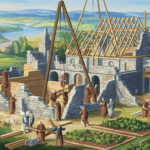
The Dark Ages, characterized by its lack of centralized governance and pervasive violence, saw the emergence of a legal framework that was both harsh and draconian. From trial by ordeal to gruesome executions, justice in the Dark Ages was a spectacle designed to instill fear and maintain order in a chaotic world.
Dark Ages crime ranged from petty theft to heinous acts like murder and treason. The lack of sophisticated policing meant that crime detection was rudimentary at best, relying heavily on community involvement and rudimentary investigative techniques. The societal structure of the time, with its rigid class distinctions, also influenced how crimes were perceived and punished. For instance, crimes against nobility were treated with greater severity than those against commoners.
During the Anglo-Saxon and early medieval period, enforcement of law and order was based on community action. Families and individuals in villages served as the police themselves. The hue and cry shows how law enforcement was conducted in the local community, in an age long before a proper police force existed. A victim of or a witness to a crime would raise the hue and cry by shouting. Everyone in the village was expected to help and join the search to catch the criminal. If a person did not join, the whole village would be liable for a fine.

Trial by Ordeal: A Test of Divine Judgment
One of the most infamous aspects of medieval justice was the trial by ordeal. This method was based on the belief that divine intervention would reveal the truth. Accused individuals were subjected to painful and dangerous tests, such as carrying a red-hot iron or being submerged in water. Survival or healing without infection was seen as proof of innocence. However, this method was not only arbitrary but also heavily biased against the accused, who often faced severe injuries or death regardless of their guilt or innocence.
Harsh Punishments: A Deterrent for Crime
Punishments during the Dark Ages were designed to be public spectacles that served as deterrents to others. The most common forms included execution by hanging or beheading for serious crimes like murder and treason. For lesser offenses, corporal punishments such as whipping or mutilation – like cutting off a hand for theft – were prevalent. Public humiliation was another tool used to maintain order; offenders might be placed in stocks or pillories where they were subjected to public ridicule and abuse.

Capital Punishment: Execution Methods
Execution methods varied depending on the crime and social status of the offender. Hanging was the most common form of execution for commoners, while nobility might face beheading by sword or axe. More gruesome methods included burning at the stake for heretics or breaking on the wheel for particularly heinous crimes. These executions were public events meant to reinforce societal norms and deter potential criminals through fear.
The Role of Wergild and Botgild
Before the Norman Conquest, Anglo-Saxon law utilized systems like wergild and botgild – fines paid to victims or their families – as compensation for crimes such as murder or bodily injury. The amount depended on the victim’s social status; higher compensation was required for crimes against nobles compared to commoners. This system aimed to prevent blood feuds by providing a structured form of restitution.

The Influence of Religion on Justice
The Church played a significant role in shaping medieval justice. Religious beliefs permeated legal practices, influencing both trials and punishments. For instance, certain crimes like witchcraft were heavily prosecuted due to religious doctrines, often resulting in execution. Additionally, public penance and religious shunning were common punishments for moral transgressions like adultery.
Transition from Ordeal to Jury Trials
By the 13th century, significant changes began to occur within the justice system. The Fourth Lateran Council in 1215 prohibited clergy from participating in ordeals, leading to their gradual replacement with jury trials. This shift marked a move towards a more structured legal process, although torture remained permissible if suspects refused trial by jury.

Conclusion: A Legacy of Brutality
The justice system of the Dark Ages left a lasting legacy characterized by its brutality and emphasis on deterrence through fear. While modern perceptions often view this period through a lens of barbarism, it is essential to recognize that these practices were reflective of their time – a time when maintaining order amidst chaos required extreme measures. Despite its harshness, this system laid foundational elements for future legal developments, including trial by jury and codified laws.




